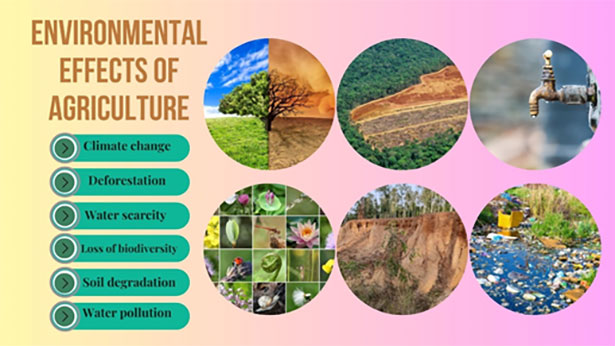Veganism is defined as a “philosophy and way of living that seeks to exclude, as far as is possible and practicable, all forms of exploitation of animals for food, clothing or any other purpose. ” The proposition asks that people choose to Go Vegan, not Be Vegan, implying that this is a journey, not a destination. I highly recommend this journey on ethical, health and environmental grounds. I will now focus on the environmental reasons to Go Vegan. It is undeniable that human civilization has adversely impacted life-support systems on the planet.
Jainavenue is a medium to serve the spiritual path of Jainism


Scientists have identified Nine Planetary boundaries that we must stay within for the sustainability of life on Earth. At the moment, we have transgressed six of them and any one of these transgressions could end life as we know it. The good news is that when we Go Vegan, we help resolve all six of them. That’s the power we have as individuals to reverse our existential crisis. Animal agriculture is the leading cause of ecological destruction because it uses 37% of the ice-free land area of the planet just to graze animals. Animal agriculture is the only major activity in which we destroy forests and replace them, not with other trees for timber or paper, but with grass, which drastically reduces the diversity of life that the land can support. Animal agriculture is the primary reason why humans have reduced the number of trees on the planet by half, from 6 trillion to 3 trillion, over the past 10,000 years. Restoring those 3 trillion trees can draw down enough carbon to completely reverse climate change. Animal agriculture is grossly inefficient because animals must eat 39 pounds of plants to produce one pound of human food, on average, a burden which the world can no longer afford. By going Vegan, we can give nearly 40% of the ice-free land area of the planet, as well as the entire ocean, back to nature. When we restore the native ecosystems on that land, we can grow most of the 3 trillion trees that we cut down over the past 10,000 years. This helps resolve all six planetary-boundary transgressions.
The least violated transgression is fresh-water change. Rewilding the land that is currently used for grazing animals will restore the fresh-water cycles of the planet. The next is land-system change. Going vegan will allow us to return nearly 40% of the land area of the planet back to nature, resolving this planetary-boundary transgression.
The next worst transgression is climate change, which can be resolved when the excess carbon in the atmosphere is absorbed in the trees and soil that we can restore to the ecosystems of the planet.
The next is chemical pollution, which would be safely stored away in regenerating forests when we Go Vegan. Eating animal foods currently delivers concentrated doses of this chemical pollution into our bodies through bioaccumulation. Therefore, going Vegan addresses chemical pollution for both the Earth and us. The next worst transgression is nitrogen and phosphorus loading, mainly through our overuse of synthetic fertilizers for crops. Since over half the crop outputs are fed to farmed animals, going Vegan will resolve this transgression as well.

All of these transgressions impact wildlife, and biodiversity loss is the worst of the six planetary-boundary transgressions. By restoring habitats for wild animals and allowing them to live freely in the ocean, we will resolve this transgression as well. If instead, we let wild animals die, we die. There are two explanations for perhaps the gravest threat ever posed to civilization – and all life on earth: – the imminent danger of runaway climate change. One explanation–the one we hear about all the time from our leading climate spokespeople–is the burning of fossil fuels. It is certainly true that the burning of fossil fuels contributes greenhouse gases to the atmosphere, thereby warming the planet. But the other explanation – what I call the Cow in the Room—is rarely addressed. The human folly of exploiting animals is animal agriculture. When these two sources of greenhouse gases are compared in the media, fossil-fuel burning is always emphasized and is almost always assigned the greater responsibility for warming the planet. But the opposite is true. When you factor in the potential carbon absorption of the forest land cleared for animal agriculture, you find that animal agriculture is responsible for at least 87% of greenhouse gasses on an annual basis. When I made that calculation, I did not include the respiration of farmed animals. I did not include the bottom trawling of the oceans by industrial fishing. I did not include the carbon released by pasture-maintenance fires set annually on grazing lands around the world. I did not include the loss of phytoplankton populations and sea forests due to industrial fishing. I did not include those factors mainly because they haven’t been reliably assessed due to a futile attempt by the orthodoxy to hide the Cow in the Room. But it seems clear to me that if we could estimate these factors and include them in the calculation, we would find that animal agriculture is responsible for – wait for it – well over 100% of greenhouse gas emissions into the atmosphere. Now that sounds unbelievable. How could it possibly be responsible for more than 100%? Because the evidence points to the possibility that the earth will start cooling in a Vegan world even if we continue to conduct all our other activities as we do today.
The cessation of animal agriculture will result in healthy oceans, healthy forests and healthy soils, and if we want to reverse climate change, then we must adopt a strategy that can draw down greenhouse gases from the atmosphere. Healthy oceans and sea forests can do that. Healthy soils and trees can do that. Solar panels and electric cars cannot. Now, I am not a supporter of the fossil fuel industry–far from it. It is my engineering assessment that we must wean ourselves off fossil fuels gradually. But we burn fossil fuels to heat and cool our homes, to transport ourselves, to manufacture goods, to ship goods. These are all social goods. What social good comes from animal agriculture? Nothing. Only obesity, heart disease, diabetes, cancer, biodiversity destruction, soil depletion, fouling of our waterways, antibiotic resistance, dangerous and dehumanizing work, animal cruelty, climate catastrophe, world hunger and let’s not forget pandemics. Indeed, there is nothing that will not improve when we end the cruelty and folly of exploiting animals.
I have just given you the intellectual reasons to Go Vegan, but lasting change comes not from the head, but from the heart. In that regard, I have made a pinky promise to our granddaughter, Kimaya, that the world will go largely Vegan by 2026, which is the year we will have killed almost all the wild animals if we don’t change course.
References:
- https://www.youtube.com/watch?v=6HJetz7S0m4
- https://www.vegansociety.com/about-us/history
- Richardson, et al., “Earth beyond six of nine planetary boundaries”, Science Advances, Vol 9 Issue 37, 2023. https://www.science.org/doi/10.1126/sciadv.adh2458
- IPCC Special Report on Climate Change, Desertification, Land Degradation, Sustainable Land Management, Food Security, and Greenhouse gas fluxes in Terrestrial Ecosystems, UN Intergovernmental Panel on Climate Change, Aug 2019 (see bar chart C on Page 4) https://www.ipcc.ch/site/assets/uploads/2019/08/Fullreport-1.pdf
- L. Watling, E. A. Norse, “Disturbance of the seabed by mobile fishing gear: A comparison to forest clearcutting,” Conservation Biology, vol 12, no 6, Dec 1998, pp. 1180-1197 https://marine-conservation.org/archive/mcbi/Watling_&_Norse_1998.pdf
- Crowther, T.W., et. al., Mapping Tree Density at a Global Scale, Nature 525, Sep 2015, pp. 201-205. https://www.nature.com/articles/nature14967
- Smith P., M. Bustamante, H. Ahammad, H. Clark, H. Dong, E.A. Elsiddig, H. Haberl, R. Harper, J. House, M. Jafari, O. Masera, C. Mbow, N. H. Ravindranath, C. W. Rice, C. Robledo Abad, A. Romanovskaya, F. Sperling, and F. Tubiello, 2014: Agriculture, Forestry and Other Land Use (AFOLU). In: Climate Change 2014: Mitigation of Climate Change. Contribution of Working Group III to the Fifth Assessment Report of the Intergovernmental Panel on Climate Change [Edenhofer, O., R. Pichs-Madruga, Y. Sokona, E. Farahani, S. Kadner, K. Seyboth, A. Adler, I. Baum, S. Brunner, P. Eickemeier, B. Kriemann, J. Savolainen, S. Schlömer, C. von Stechow, T. Zwickel and J.C. Minx (eds.)]. Cambridge University Press, Cambridge, United Kingdom and New York, NY, USA (see Chapter 11, Fig 11.9, page 836). https://www.ipcc.ch/site/assets/uploads/2018/02/ipcc_wg3_ar5_chapter11.pdf
- McKay, et al. “Exceeding 1.5C global warming could trigger multiple climate tipping points,” Science Vol 377, Issue 6611, 2022 DOI: 10.1126/science.abn79 https://www.science.org/doi/10.1126/science.abn7950
- Rao, S. K., “Animal Agriculture is the Leading Cause of Climate Change: A Position Paper,” Journal of Ecological Society, vol 32-33, pp. 155-167, 2021. https://www.scienceopen.com/hosted-document?doi=10.54081/JES.027/13
About Author
Dr. Sailesh Rao ( Founder of Climate Healers )
Dr. Rao is a systems specialist with a Ph. D. in Electrical Engineering from Stanford University and worked on the internet communications infrastructure for twenty years after graduation. During this period, he blazed the trail for high-speed signal processing chips and technologies for High Definition Television, real-time video communications and the transformation of early analog internet connections to more robust digital connections, while accelerating their speeds ten-fold. Today, over a billion internet connections deploy the communications protocol that he designed. He is the author of 22 peer-reviewed technical papers, 50 standards contributions, 10 US patents and 3 Canadian patents. He was the co-founder of Silicon Design Experts in 1991 which was acquired by Level One Communications in 1996 and which was later acquired by Intel Corporation in 1999 for $2.2 billion.
In 2006, he switched careers and became deeply immersed, full time, in solving the environmental crises affecting humanity. Dr. Rao is the author of four books, Carbon Dharma: The Occupation of Butterflies, Carbon Yoga: The Vegan Metamorphosis, Animal Agriculture is Immoral and The Pinky Promise, and an Executive Producer of several documentaries, The Human Experiment (2013), Cowspiracy: The Sustainability Secret (2014), What The Health (2017), A Prayer for Compassion (2019), They’re Trying to Kill Us (2021), The End of Medicine (2022), The Land of Ahimsa (2022), Animals – A Parallel History (est. 2023) and Milked (2022).
More about Dr Rao:.
https://climatehealers.org/sailesh-rao/


Wonderful beat I wish to apprentice while you amend your web site how could i subscribe for a blog web site The account aided me a acceptable deal I had been a little bit acquainted of this your broadcast provided bright clear idea
I do believe all the ideas youve presented for your post They are really convincing and will certainly work Nonetheless the posts are too short for novices May just you please lengthen them a little from subsequent time Thanks for the post
Bwer Pipes: Pioneering Irrigation Excellence in Iraq: Explore Bwer Pipes for cutting-edge irrigation solutions that set the standard for excellence in Iraqi agriculture. Our advanced sprinkler technology and durable pipes deliver precise water distribution, enabling farmers to achieve optimal crop yields and sustainable farming practices. Explore Bwer Pipes
Wow amazing blog layout How long have you been blogging for you made blogging look easy The overall look of your web site is magnificent as well as the content